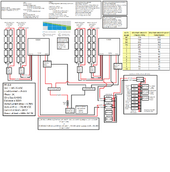Hello All,
With some reading and some direct help from people from this forum, I believe I finally got my system planned layout to the point of execution. But before I do, I wanted to have some other eyes reviewing if I may have missed anything. I live in the USA and I suspect I will need to get a permit to do everything I plan to do. I will setting this up in the concrete basement of my home. I have 2 of the 6.5kW All in Ones (Rich Solar H6548) that I will set up as split phase so that I can mainly charge my Tesla and to power most of my electrical needs from my home. That will definitely take a licensed electrician to rewire from my home breaker to the off-grid breaker. I will also be expanding the battery bank (3.2 280Ah cells already purchased) from 1 to 4 as I get 3 more active balancer BMS's. I have 32kW of solar panels (Hyperion bifacial 400W) but will be using 16kW for now. I will be buying the rest of the components next year (busbars, pv cables, battery cables, disconnects, circuit breakers, t-fuses, combiner box, load centers with main breaker).
I do need more understanding on which T-fuses to buy and the bus bar to get in preparation for 4 battery banks. Sorry in advance for my simplistic drawing.
With some reading and some direct help from people from this forum, I believe I finally got my system planned layout to the point of execution. But before I do, I wanted to have some other eyes reviewing if I may have missed anything. I live in the USA and I suspect I will need to get a permit to do everything I plan to do. I will setting this up in the concrete basement of my home. I have 2 of the 6.5kW All in Ones (Rich Solar H6548) that I will set up as split phase so that I can mainly charge my Tesla and to power most of my electrical needs from my home. That will definitely take a licensed electrician to rewire from my home breaker to the off-grid breaker. I will also be expanding the battery bank (3.2 280Ah cells already purchased) from 1 to 4 as I get 3 more active balancer BMS's. I have 32kW of solar panels (Hyperion bifacial 400W) but will be using 16kW for now. I will be buying the rest of the components next year (busbars, pv cables, battery cables, disconnects, circuit breakers, t-fuses, combiner box, load centers with main breaker).
I do need more understanding on which T-fuses to buy and the bus bar to get in preparation for 4 battery banks. Sorry in advance for my simplistic drawing.





